Description
- Functionality:
- TTL to CMOS Conversion: Converts TTL logic levels (0V to 5V) to CMOS logic levels (0V to Vcc), enabling communication between TTL and CMOS devices.
- CMOS to TTL Conversion: Converts CMOS logic levels (0V to Vcc) to TTL logic levels (0V to 5V), facilitating interoperability between CMOS and TTL devices.
- TTL to RS-232 Conversion: Converts TTL logic levels to RS-232 voltage levels (-15V to +15V), allowing TTL devices to communicate with RS-232 serial devices such as computers and modems.
- Types of Converters:
- Bi-Directional Converters: Support bidirectional conversion between TTL and other logic levels, allowing data transmission in both directions.
- Uni-Directional Converters: Support conversion in one direction only, typically from TTL to another logic level or vice versa.
- Multi-Channel Converters: Feature multiple input and output channels, enabling simultaneous conversion of multiple signals or communication lines.
- Features and Benefits:
- Voltage Level Translation: Provides seamless conversion between TTL and other logic levels, ensuring compatibility and reliable data transfer in mixed-signal environments.
- Plug-and-Play Operation: Requires minimal configuration and setup, allowing for quick and easy integration into digital circuits and communication systems.
- Signal Conditioning: Incorporates signal conditioning features such as voltage level shifting, signal amplification, and noise filtering to enhance signal integrity and minimize transmission errors.
- Compact and Portable Design: Compact form factor and lightweight construction make the TTL converter suitable for portable and space-constrained applications, offering flexibility in deployment.
- Applications:
- Embedded Systems: Used in embedded systems and microcontroller-based projects to interface with peripherals, sensors, and communication modules operating at different logic voltage levels.
- Industrial Automation: Integrated into industrial automation systems for connecting PLCs (Programmable Logic Controllers), sensors, and actuators with control units and monitoring devices.
- Communication Networks: Deployed in communication networks and data acquisition systems for converting signals between TTL and RS-232, RS-485, or other serial communication standards.
- Test and Measurement: Employed in test and measurement equipment for signal conversion and interface adaptation, enabling compatibility with a wide range of testing instruments and devices.
- Considerations:
- Voltage Compatibility: Ensure that the TTL converter supports the voltage levels required by the connected devices to prevent damage and ensure reliable operation.
- Data Rate: Verify the maximum data rate supported by the TTL converter to meet the communication requirements of the application, especially in high-speed data transmission scenarios.
- Power Supply: Provide a stable power supply within the specified voltage range to the TTL converter to ensure proper operation and signal integrity.
- Environmental Conditions: Consider environmental factors such as temperature, humidity, and electromagnetic interference (EMI) when selecting a TTL converter for outdoor or harsh industrial environments.






